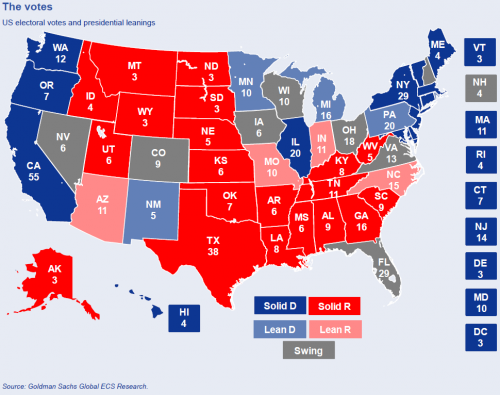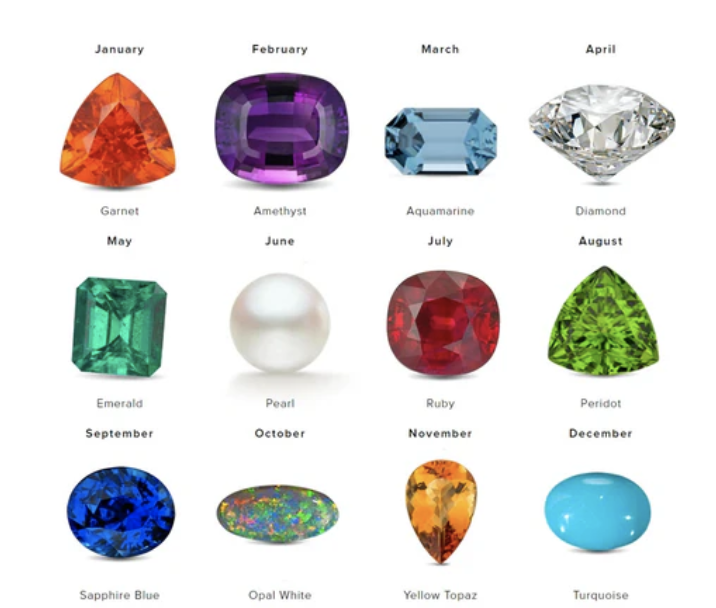Electoral Map Blues

Here is a map of the electoral college with the swing states in gray. Courtesy of Goldman Sachs Global Research.
March 12, 2015
The Republicans are going into the 2016 presidential election at a disadvantage. Not only do the Democrats have a leg up in the electoral college, but their nominee is essentially already chosen. A coronation makes for a boring primary season–and that is basically what is happening with Hillary Clinton and the Democrats. Of course, nothing is for sure in politics, but right now it seems that Clinton’s nomination is imminent. On the other hand, the large and crowded field of potential Republican nominees is causing some in the GOP to question what they want in a nominee. Conservative? Libertarian? Populist? Well the first thing on everyone’s list should be someone electable, and that starts in the electoral college.
There are two important areas of the country that contain the majority of the swing states: the Midwest (Iowa, Wisconsin, Ohio, Pennsylvania) and the Southeast (Virginia, North Carolina, Florida). Interestingly, both areas have become more moderate in recent years due to demographic changes, but in opposite respects. The rust belt seems to becoming more and more conservative as evidenced by the election of Republican state legislature majorities, Governors, and Senators in this region. Although states like Minnesota and Illinois are still reliably Democratic, states like Wisconsin, Pennsylvania, and Michigan that have been strictly blue states since the 1980s actually have a chance (albeit in some cases a small one) of becoming GOP pickups this election cycle. Conversely, the Southeast has become more and more liberal. This is because of growing minority populations, like African-Americans and Latinos, which tend to vote for the Democratic party. This has changed states like Virginia and North Carolina into swing states and has caused the DNC to think about Georgia as a potential campaign stop. Florida, although in the area, is a little different than the rest of the southeast. It has consistently been a swing state, but its conservative Cuban population has given it a red tint. The other three swing states are Colorado, Nevada, and New Hampshire. Colorado and Nevada, just like in the southeast, have become swing states because of changing demographics and in the case of these two states it is because of Latino immigrants. New Hampshire is probably the most interesting of all because it is a swing state despite the fact that it rests in the middle of one of the most liberal areas of the country–New England. Naturally the Granite State has a blue tint but will definitely be in play in 2016.
There are only a few paths to the presidency for the GOP and the easiest one involves winning big in the Midwest. No Republican has ever won the presidency without winning Ohio, so winning those 18 electoral votes, along with one or two other states in the region, is imperative for the GOP. One Republican candidate who could be successful in this region is Wisconsin Governor Scott Walker. The reason President Obama was so successful in the Midwest during his reelection is because of the 2009 Auto Bailout–the blue collar Americans that dominate the region respected him for that. But Walker could be successful in this region for a different reason. Not only is he a native to this region, but he was elected to be the Governor of Wisconsin, three times in the last four years. One of those elections was because of a recall election about a controversy over Act 10, a bill that eliminated many of the rights of public sector unions to collectively bargain, where he was handily reelected. He proved that he can fight public sector labor unions and win. Unions used to be a big part of the rust belt, but in the past few decades the power of labor unions has declined dramatically which has contributed to this area becoming more moderate. Therefore, in some areas where union membership is still relatively strong, this reputation could hurt him.
Another chance for the GOP is if the Republicans can win more than 40% of the Hispanic vote, as they did in 2004 when Bush was reelected, then there is a great chance that Republicans can win the White House. Last year Mitt Romney received only 27% of the Hispanic vote which was the lowest number since Bob Dole ran in 1996. Hispanics are a minority that the GOP can and should target because they are the fastest growing minority in the country and as long as the GOP retains its reputation as the “stingy, old, white guys” then there will never be another Republican president again. Therefore, two candidates that could be attractive to Hispanic voters are Florida Senator Marco Rubio and former Florida Governor Jeb Bush. Rubio is a second generation Cuban-American and presents a fresh face to the Republican party. Bush speaks fluent Spanish, has a Mexican wife, and his brother was relatively popular with Hispanics. Both of these potential candidates have two things in common: they come from a swing state with many Latino voters and are in favor of some sort of immigration reform. These things could definitely help them in the general election where states like Colorado and Nevada are on the table.
Clearly, the Republicans are going to have an uphill battle in 2016, but the disadvantage they face may be overstated by many in the media. Mr. Honig argues that “it’s a difficult map for them, but one in which they can win.” This is absolutely true. If the GOP loses in 2016 it can’t blame anyone but itself. The Democrats do have a distinct advantage, but it is not so overwhelming that the Republicans cannot triumph. The Republicans will just have to remember to nominate someone who can win on the electoral map that they are given.




































